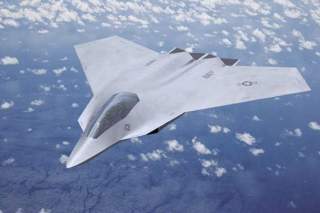America's 5 Next Generation Super Weapons
New ships, submarines and aircraft are on the drawing boards that will help maintain America’s edge over Beijing and Moscow.
The United States military is far by the most technologically advanced and capable force the Earth has ever seen.
From satellites, to stealth fighters and bombers, to advanced surface ships and submarines, America’s arsenal is unmatched by any other power. But American military supremacy rests on maintaining that technological edge. Even now, Russia and China are advancing their capabilities in the hopes of one day matching or even exceeding U.S. capabilities.
But the Pentagon isn’t standing still. Even now, new ships, submarines and aircraft are on the drawing boards that will help maintain America’s edge over Beijing and Moscow. However, first those efforts must navigate the Byzantine labyrinth that is the Pentagon bureaucracy and secure funding from the U.S. Congress.
LRS-B:
The centerpiece of future American dominance in the Western Pacific and around the world is the U.S. Air Force’s Long Range Strike Bomber (LRS-B) program. The new bomber is being designed to fly over vast distances into the teeth of enemy air defenses to deliver a bomb load before the enemy even knows it’s there. But unlike previous U.S. stealth bomber efforts, the LRS-B is just one part of a larger family of systems. Reconnaissance assets, electronic attack platforms, cruise missiles and other systems will accompany the bomber as it flies into enemy airspace. Moreover, the bomber will be designed so that it can be optionally manned. Northrop Grumman and Boeing are battling over the right to build the new plane.
F-X:
While often thought of as a “new” aircraft, 2015 marks the tenth year that the U.S. Air Force’s mighty F-22 Raptor has been in service. The Air Force is already starting to look at midlife structural upgrades for its surviving fleet of 186 Raptors—especially the oldest aircraft at Tyndall AFB, Fla. Moreover, the service never received enough Raptors to replace the Boeing F-15C Eagle, which also has to be replaced.
The F-X will replace both the F-22 and the F-15C. Exactly what form the F-X will take is not yet known, but the Air Force is looking at a range of options based on the kinds of threats it expects in the post-2030 world. Options range from a new aircraft to a combination of drones and manned aircraft to new versions of existing planes. But whatever emerges from the F-X analysis of alternatives—which will be conducted jointly with the U.S. Navy—will likely dominate the skies once it enters production later this century.
F/A-XX:
The U.S. Navy also has a next-generation fighter program in the works to replace the long-serving F/A-18E/F Super Hornet in the 2030s. The service is about to kick-off a joint analysis of alternatives with the Air Force, which needs to replace its Raptors and F-15Cs. Like the Air Force, the Navy is looking at concepts like manned-unmanned teaming and a family of systems approach to the problem. The service has not decided what the F/A-XX will look like—but early indications are that it will be a less offensively oriented weapon than the Air Force’s F-X.
Right now, the Navy’s focus seems to be a geared toward a multirole aircraft. However, many in industry and the think-tanks like the Hudson Institute believe the Navy should focus on a jet with an air-to-air bias in light of new threats like the J-20. The F/A-XX will probably be accompanied on the flight deck by a second-generation naval unmanned combat aircraft if the Navy has its way. Only time will tell.
SSN(X):
The U.S. Navy’s Seawolf and Virginia-class attack submarines are the most capable boats in the world. But the Navy has to prepare for a future where next-generation Russian and Chinese submarines lurk under the waves. As such, the Navy has started preparation work on the next-generation of attack submarines, which it is calling the SSN(X). Work on planning for the new vessels started last year, but the service offered some additional details at the Naval Submarine League’s annual symposium this year.
According to Naval Sea Systems Command’s George Drakely, who is the executive director of Program Executive Office-Submarines, the service plans to begin an analysis of alternatives in 2024 for the new attack boat—as reported by Seapower Magazine. Construction will probably start in in 2034. Drakely said that affordability would be a key focus of the design. The boat will make extensive use of off-board sensors.
FSC:
The U.S. Navy will also have to replace its long-serving DDG-51 destroyers. The Navy has said that it is looking for a new Future Surface Combatant that would enter service in the 2030s. The new ships are expected to incorporate new technologies like lasers, electromagnetic rail guns and advanced powers systems. Those new innovations are needed to keep pace with a rapidly evolving threat—especially as potential enemies have developed precision guided weapons that can threaten the carrier strike group. Weapons like lasers and railguns would break the per shot cost curve. Instead of a $10 million SM-3 interceptor shooting down a $2 million anti-ship ballistic missile, a single railgun slug might cost a few thousand dollars.
Dave Majumdar is the defense editor for The National Interest. You can follow him on Twitter: @davemajumdar.

